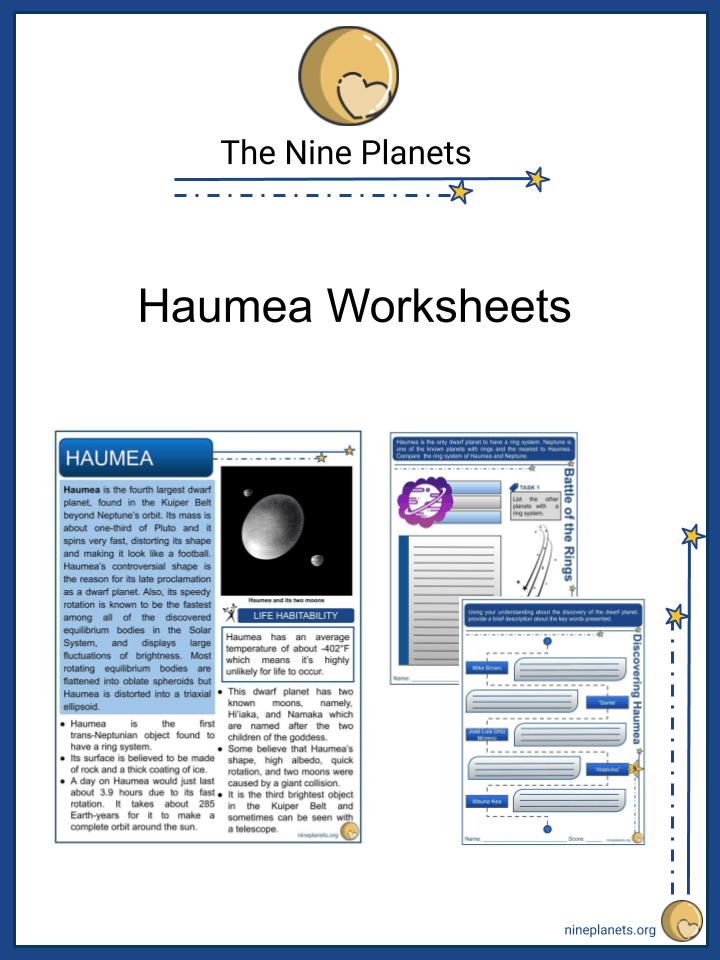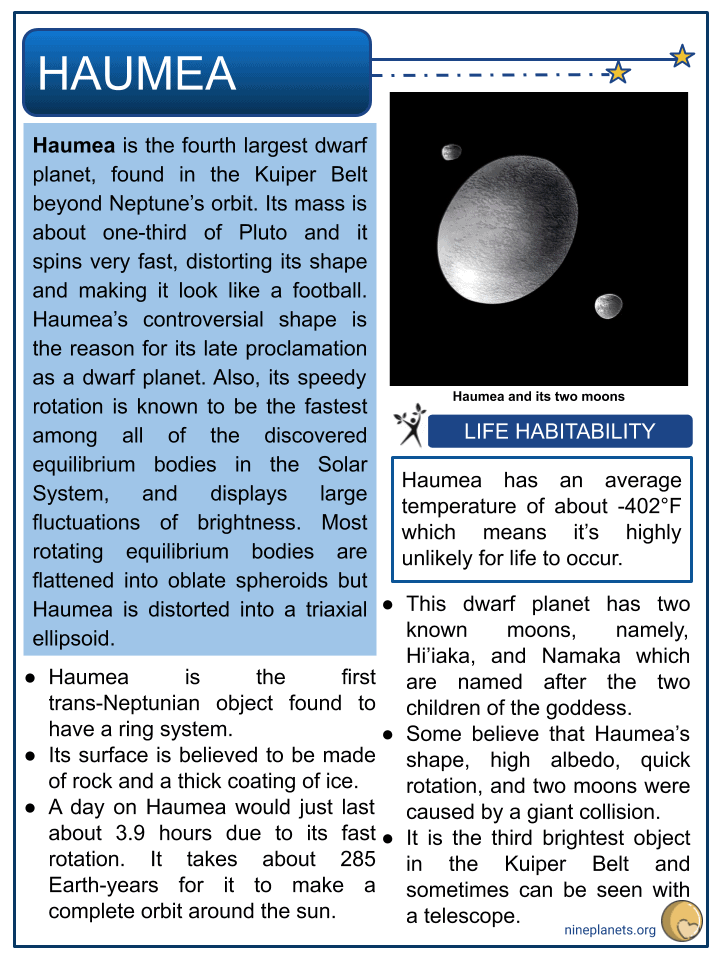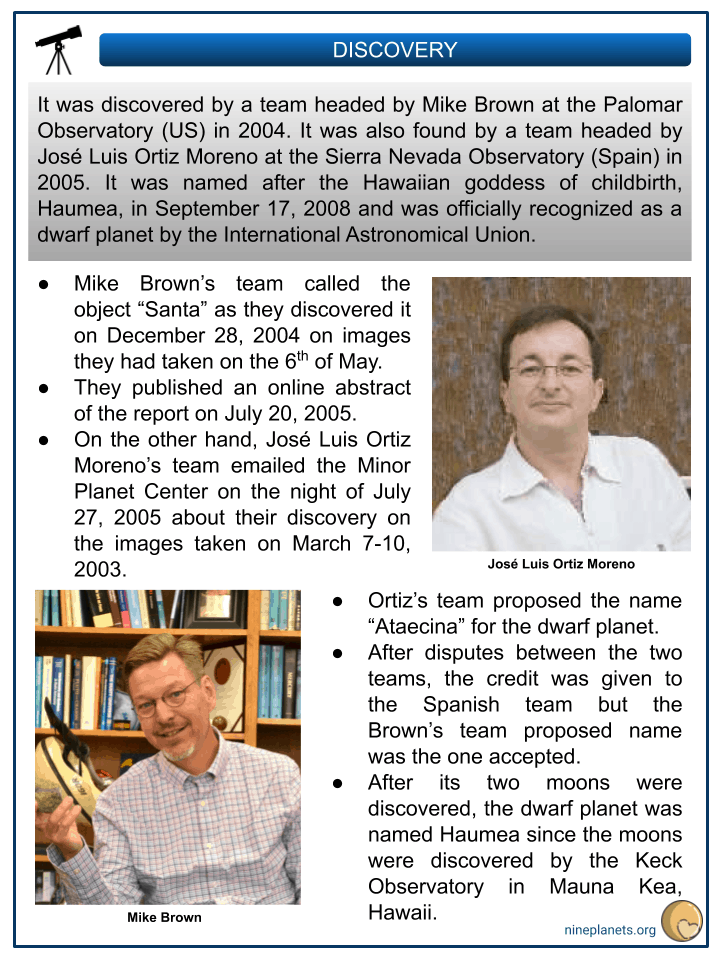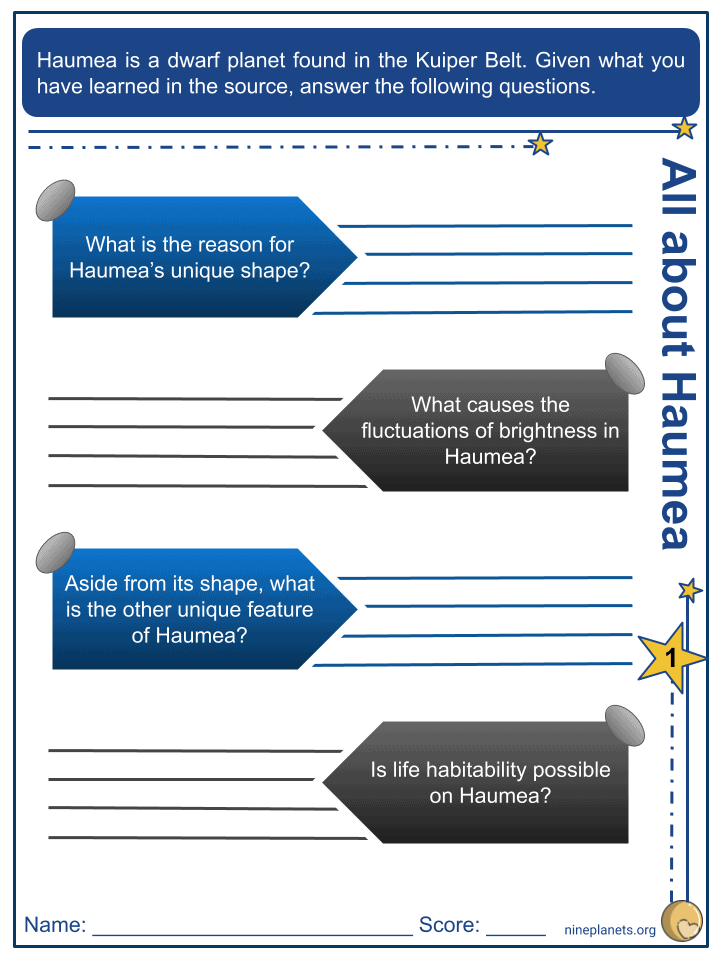Download Haumea Worksheets
Click the button below to get instant access to these premium worksheets for use in the classroom or at a home.

This worksheet can be edited by Premium members using the free Google Slides online software. Click the Edit button above to get started.
Download free sample
Not ready to purchase a subscription yet? Click here to download a FREE sample of this worksheet pack.
Resource Examples
Click any of the example images below to view a larger version.




Key Facts & Information
- Haumea is the fourth largest dwarf planet, found in the Kuiper Belt beyond Neptune’s orbit. Its mass is about one-third of Pluto and it spins very fast, distorting its shape and making it look like a football. Haumea’s controversial shape is the reason for its late proclamation as a dwarf planet. Also, its speedy rotation is known to be the fastest among all of the discovered equilibrium bodies in the Solar System, and displays large fluctuations of brightness. Most rotating equilibrium bodies are flattened into oblate spheroids but Haumea is distorted into a triaxial ellipsoid.
- Haumea is the first trans-Neptunian object found to have a ring system.
- Its surface is believed to be made of rock and a thick coating of ice.
- A day on Haumea would just last about 3.9 hours due to its fast rotation. It takes about 285 Earth-years for it to make a complete orbit around the sun.
Life Habitability
- Haumea has an average temperature of about -402°F which means it’s highly unlikely for life to occur.
- This dwarf planet has two known moons, namely, Hi’iaka, and Namaka which are named after the two children of the goddess.
- Some believe that Haumea’s shape, high albedo, quick rotation, and two moons were caused by a giant collision.
- It is the third brightest object in the Kuiper Belt and sometimes can be seen with a telescope.
Discovery
- It was discovered by a team headed by Mike Brown at the Palomar Observatory (US) in 2004. It was also found by a team headed by José Luis Ortiz Moreno at the Sierra Nevada Observatory (Spain) in 2005. It was named after the Hawaiian goddess of childbirth, Haumea, in September 17, 2008 and was officially recognized as a dwarf planet by the International Astronomical Union.
- Mike Brown’s team called the object “Santa” as they discovered it on December 28, 2004 on images they had taken on the 6th of May.
- They published an online abstract of the report on July 20, 2005.
- On the other hand, José Luis Ortiz Moreno’s team emailed the Minor Planet Center on the night of July 27, 2005 about their discovery on the images taken on March 7-10, 2003.
- Ortiz’s team proposed the name “Ataecina” for the dwarf planet.
- After disputes between the two teams, the credit was given to the Spanish team but the Brown’s team proposed name was the one accepted.
- After its two moons were discovered, the dwarf planet was named Haumea since the moons were discovered by the Keck Observatory in Mauna Kea, Hawaii.
Physical Characteristics
- Haumea is one of the objects that orbit in the Kuiper Belt, a disc-like zone beyond the orbit of Neptune. These objects are called trans-Neptunian objects or plutoids. The Haumea or the Haumean family is the only known trans-Neptunian collisional family and is believed to have formed in the early history of our Solar System about 4.5 billion years ago.
- ROTATION
- Haumea displays large fluctuations in brightness for about 3,9 hours due to its rotation period.
- This rotational speed is the fastest among equilibrium bodies in the Solar system and is also faster than any known object with 100 km diameter.
- Its shape, triaxial ellipsoid, is also due to its rotation.
- If it rotated much more rapidly, it would distort itself into a dumbbell shape and would split in two
- SIZE AND MASS
- The size of an object in the Solar System can be deduced from its optical magnitude, distance, and albedo.
- Objects appear bright from our point of view either because they are large or because they are highly reflective.
- Haumea is large and bright enough for its thermal emission to be measured, giving approximate value for its albedo and size.
- However, it is thought that most of the fluctuation in Haumea’s brightness is not caused by the differences in albedo but by the alteration of its side view and end view.
- Haumea has a radius of about 385 miles, about 1/14 of the radius of the Earth.
- Haumea has a diameter of about 1014 miles and three Haumeas can fit side by side into Earth.
- It is also believed that Haumea lost about 20% of its mass during a collision.
- SURFACE AND COMPOSITION
- The Gemini and Keck telescopes obtained spectra of Haumea showing strong crystalline water features similar to Charon, Pluto’s moon, in 2005. Crystalline ice forms at temperatures above 110 but Haumea’s temperature is below 50 K, favorable for amorphous ice to be formed.
- Radiation damage should also redden and darken the surface of the trans-Neptunian objects with organic ices and tholin-like compounds
- The spectra and color suggest that Haumea have undergone recent resurfacing, producing fresh ice.
- It is thought that Haumea is made up entirely of rock covered by a thin icy shell.
- Further studies of the visible and near infrared spectra suggest that it has a homogenous surface of an intimate mixture of amorphous and crystalline ice, with no more than 8% organics.
- Haumea is also one of the densest objects in the Kuiper Belt, with a density of 1.885 g/cm3, covering the values for silicate materials such as olivine and pyroxene, which make up a lot of the rocky objects in the Solar System.
Haumea’s Ring System
- A stellar occultation observed and described in 2017 indicated the presence of a ring around Haumea, making it the first ring system discovered for a trans-Neptunian object.
- The ring has a radius of about 2,287 km, a width of about 70 km and an opacity of 0.5.
- The ring plane approximately coincides with the plane of Haumea’s equator and its orbital plane is the same with its outer moon, Hi’aka.
- The particles in the ring are close to the 3:1 resonance with Haumea’s rotation.
- Ring particles make one revolution for every three rotations of Haumea.
- Haumea’s ring is also estimated to contribute to 5% of its total brightness.
- Haumea is the only dwarf planet to have a ring system and the most distant object of the known Solar System to have one.
Haumea’s Moons
- Two moons orbiting Haumea were discovered by Darin Ragozzine and Michael Brown in 2005 through the use of W.M. Keck Observatory in Mauna Kea, Hawaii. It is believed that Hi’aka and Namaka were fragments of Haumea from a collision.
- HI’IAKA
- Hi’aka was first named as “Rudolph” by the Caltech Team when it was discovered on January 26, 2005.
- It is the outer and larger moon, and is about 310 km in diameter.
- It orbits Haumea in a nearly circular path every 49 days.
- Infrared spectrum analysis suggests that it is also covered with pure crystalline ice.
- NAMAKA
- Namaka was first named as “Blitzen” and was discovered on June 30, 2005.
- It is the smaller, inner moon, whose mass is about one-tenth that of Hi’iaka.
- It orbits Haumea in 18 days in a highly elliptical, non-Keplerian orbit.
- The orbits of Hi’aka and Namaka appear almost exactly edge-on Earth, with Namaka periodically hiding-occulting, Haumea.
Collisional Family
- Haumea is the largest member of its collisional family, which is a group of astronomical objects with similar physical and orbital characteristics thought to be formed from a shattered progenitor about 1660 km in diameter.
- The Haumean family was the first to be identified among the trans-Neptunian objects.
- Brown and his colleagues proposed that its family was a direct product of the impact from its own ice mantle.
- However, a second proposal suggests that the material formed in the initial collision coalesced into Hi’iaka, which was later shattered in a second collision, producing a dispersion of velocities for the fragments that is at a closer match to the measured velocity of the family members.
- The objects’ common physical characteristics include neutral colors and deep infrared absorption features typical of water ice.
Exploration
- Joel Poncy and his colleagues calculated that a flyby mission to Haume could take around 14.25 years using a gravity assist at Jupiter, based on a launch date on September 25, 2025.
- There are no confirmed missions to Haumea though its unique features are strong points in making a trip happen.
- Also, Probe mass, power source, and propulsion systems are key technology areas for this type of mission.
Did You Know?
- The closest approach of Haumea to Earth at a distance of 36.6 AU will happen in 2100.
- Its perihelion point is about 35 AU away from the Sun and its aphelion point is about 50 AU.
- Haumea’s gravity is about 4.5% in strength compared to the gravity of Earth.
- Haumea is the fourth largest dwarf planet among the five dwarf planets discovered.
- It is one of the fastest spinning objects discovered in the Solar System.
- Haumea’s outer moon, Hi’iaka, is eight times closer to Haumea than our moon is to Earth.
- Haumea is the largest object in its own family, namely, its moons: Hi’aka and Namaka, and the Kuiper belt objects: 2002 TX300, 1995 SM55, 1996 TO66, 2003 OP32, 2005 RR43, 1999 OY3, 2003 UZ117, (308193) 2005 CB79, 2003 SQ317 and (386723) 2009 YE7,
- There is probably no sky seen in Haumea as its gravity cannot hold on to an atmosphere.
- A person weighing 70 kg on Earth will just weigh 3 kg on Haumea due to its gravity.
Significant Dates
- 2004: Haumea’s discovery is announced from data collected in 2003.
- 2005: Haumea’s two moons are discovered
- 2008: Haumea is officially recognized as a dwarf planet by the International Astronomical Union (IAU) and named “Haumea”.